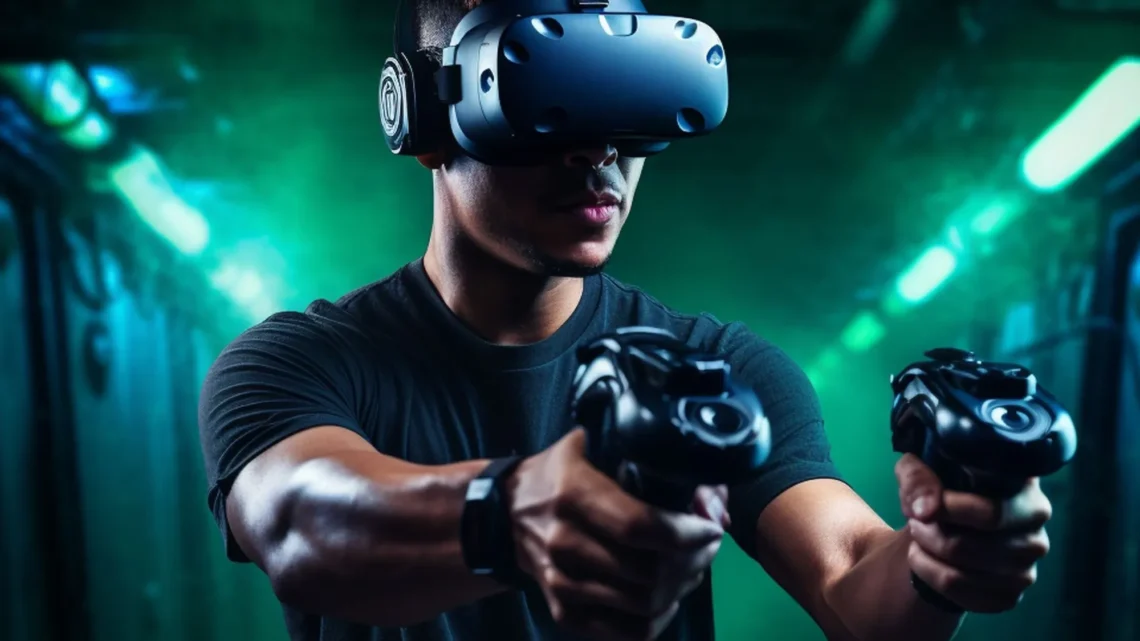Augmented Reality (AR) and Virtual Reality (VR) are revolutionizing the gaming industry, offering immersive experiences that blur the line between the physical and digital worlds. These technologies, once seen as futuristic, are now becoming mainstream, driven by advancements in hardware, software, and creativity. From enhancing gameplay mechanics to creating entirely new worlds, AR and VR are reshaping how players interact with games, making them more engaging, realistic, and interactive.
The Evolution of AR and VR in Gaming
The integration of AR and VR into gaming has been a gradual but transformative process. Early VR concepts in the 1990s were primitive, but they laid the groundwork for modern systems. As technology improved, particularly in computing power, sensors, and displays, the potential for immersive gaming experiences grew exponentially.
In the early 2000s, mobile gaming spurred the development of augmented reality, with games like Pokémon GO (2016) bringing AR to a global audience. Meanwhile, VR gained momentum with the release of devices like the Oculus Rift and HTC Vive in 2016, creating fully immersive environments for players. Today, AR and VR are no longer niche technologies; they are integral to the future of gaming.
Key Differences Between AR and VR in Gaming
AR and VR are often discussed together, but they offer distinct experiences and possibilities for gaming.
| Aspect | Augmented Reality (AR) | Virtual Reality (VR) |
| Definition | Overlays digital elements onto the real world | Creates a fully immersive digital environment |
| Hardware | Smartphones, AR glasses | VR headsets, motion controllers |
| Interaction | Combines physical and digital interaction | Full immersion in virtual spaces |
| Accessibility | More accessible via mobile devices | Requires specialized equipment |
While AR enhances the real world by adding digital elements, VR fully immerses players in a virtual environment, completely disconnecting them from their physical surroundings. Each technology has its strengths and weaknesses in the gaming context, depending on the type of experience players seek.
Augmented Reality (AR) in Gaming
AR enhances the gaming experience by overlaying digital information onto the real world, creating interactive experiences that blend the physical and virtual. This allows for innovative gameplay that can occur in everyday environments.
Popular AR Games and Applications
| Game | Platform | Main Feature |
| Pokémon GO | iOS, Android | Real-world exploration and gameplay |
| Harry Potter: Wizards Unite | iOS, Android | Location-based spell casting |
| Ingress | iOS, Android | Location-based strategy |
Real-World Integration
Games like Pokémon GO encourage players to explore real-world locations, blending physical movement with digital gameplay. The game’s success lies in its use of AR to create an engaging treasure-hunt-like experience, where players search for and capture Pokémon in real environments. This combination of virtual characters and real-world settings is the hallmark of AR in gaming.
Social Connectivity
AR games also enhance social interaction, as they often require players to collaborate or compete in real-world locations. For example, in Ingress, players form teams to capture virtual landmarks. This promotes physical activity, teamwork, and social engagement, which contrasts with traditional gaming experiences that are typically more isolated.
Mobile AR Gaming
One of the key reasons AR gaming has become mainstream is the widespread use of smartphones. With ARKit (Apple) and ARCore (Google) development platforms, mobile AR games are easier to develop and distribute, lowering the barrier to entry for both developers and players. This accessibility ensures that AR gaming continues to grow and reach a broad audience.
Virtual Reality (VR) in Gaming
VR, by contrast, creates entirely virtual environments where players can immerse themselves in a different reality. Through VR headsets, players are transported to fully rendered digital worlds, where they can interact with the environment and other players as if they were physically present.
Notable VR Games and Platforms
| Game | Platform | Main Feature |
| Half-Life: Alyx | PC (Oculus, Vive, Index) | Fully immersive first-person shooter |
| Beat Saber | Oculus, PSVR, SteamVR | Rhythm-based gameplay |
| The Walking Dead: Saints & Sinners | Oculus, SteamVR | Survival horror in a VR setting |
Immersive Gameplay
VR games offer a level of immersion that is unmatched by any other medium. In games like Half-Life: Alyx, players can interact with objects, explore environments, and experience action in first-person, all within a virtual space. The ability to look around, move, and act as if one were in a physical environment creates a profound sense of presence.
Physical Interaction
Many VR games incorporate motion controllers, allowing players to use their hands to interact with the virtual environment. In games like Beat Saber, players physically slash through blocks to the rhythm of the music. This interactivity not only enhances gameplay but also creates a more active gaming experience, blurring the lines between gaming and physical exercise.
Immersive Storytelling
VR is also transforming narrative-driven games. The immersive nature of VR allows players to experience stories from a first-person perspective, increasing emotional engagement. For example, in The Walking Dead: Saints & Sinners, players navigate a post-apocalyptic world, making decisions that impact the storyline, all while feeling fully present in the game’s environment.
The Role of Hardware in AR and VR Gaming
The success of AR and VR in gaming depends heavily on advancements in hardware. The development of specialized devices, from headsets to controllers, has been crucial in making these technologies accessible and enhancing the gaming experience.
VR Headsets
| Device | Manufacturer | Key Feature |
| Oculus Quest 2 | Wireless, standalone VR headset | |
| PlayStation VR | Sony | Console-based VR gaming |
| HTC Vive Pro | HTC | High-resolution VR experience |
Standalone vs. PC-Based VR
Early VR systems required high-end gaming PCs to function, limiting their accessibility. However, the emergence of standalone VR systems like the Oculus Quest 2 has made VR more accessible to casual gamers. Standalone headsets provide a complete VR experience without the need for a powerful PC or external sensors, expanding VR gaming to a broader audience.
Haptic Feedback and Motion Controllers
Another key development in VR hardware is the introduction of haptic feedback and advanced motion controllers. Devices like the Valve Index Controllers offer finger tracking, allowing players to interact with the virtual world more naturally. Haptic feedback adds a tactile element to gameplay, letting players feel virtual objects or actions, such as the recoil of a gunshot or the impact of a virtual object.
AR Glasses and Devices
While AR gaming is primarily mobile-based, advancements in AR-specific hardware are on the horizon. Devices like Microsoft’s HoloLens or Magic Leap offer more advanced AR experiences, where digital objects can interact seamlessly with the real world. These devices, though currently focused on enterprise use, have the potential to revolutionize AR gaming by allowing players to engage with digital elements in their surroundings more naturally.
How AR and VR Are Redefining Game Development
The integration of AR and VR into gaming requires a fundamental shift in how games are developed. Developers must not only design engaging gameplay but also create immersive environments and interactions that feel natural in both real and virtual spaces.
Challenges in Developing AR and VR Games
| Challenge | Impact on Development | Solutions |
| Motion Sickness | Can reduce player engagement | Use of advanced tracking and optimized frame rates |
| Interaction Design | Requires new control schemes | Developing intuitive gestures and controls |
| Realism in AR/VR Worlds | High development costs | Use of procedural generation and AI |
Interaction Design
Designing interactions for AR and VR requires new ways of thinking. Unlike traditional games, where players interact via a controller or keyboard, AR and VR require more intuitive methods. In VR, developers must consider how players move, look around, and interact with objects, leading to the development of motion controls and hand tracking. AR games, on the other hand, require interactions that merge seamlessly with the real world, often through gestures or touchscreens.
Optimization and Performance
Performance is a critical consideration for AR and VR games. To maintain immersion, games must run at high frame rates and respond to player actions without delay. This requires significant optimization, especially in VR, where even slight lag can cause motion sickness. Developers are constantly working on improving performance to ensure smooth, comfortable experiences for players.
Social and Multiplayer Experiences in AR and VR Gaming
Both AR and VR have the potential to redefine multiplayer gaming by creating new ways for players to interact with one another.
VR Social Spaces
VR platforms like VRChat and Rec Room allow players to socialize, play games, and create content in a virtual environment. These spaces are unique in that they offer a level of interaction and expression not possible in traditional online games. Players can use full-body avatars, gesture-based communication, and even create their own worlds within these platforms.
AR Multiplayer Experiences
AR games often rely on location-based multiplayer experiences, where players gather in real-world locations to interact with each other and the game. This creates unique social dynamics that mix digital and physical worlds. For example, Pokémon GO hosts community events where players gather in parks or city centers to catch rare Pokémon, blending social gaming with real-world exploration.
The Future of AR and VR in Gaming
As AR and VR technologies continue to evolve, their role in gaming will only become more prominent. Advancements in hardware, software, and game design are creating new possibilities for immersive experiences, from large-scale multiplayer VR worlds to AR-enhanced real-world games.
Upcoming Trends in AR and VR Gaming
| Trend | Description | Impact |
| Cloud-Based VR | Streaming VR content via the cloud | Reduces need for powerful hardware |
| AR Glasses for Gaming | Lightweight, wearable AR devices | Greater immersion in AR games |
| Haptic Suits | Full-body haptic feedback | Enhances physical interaction in VR |
Cloud-Based VR
One of the most exciting developments is the potential for cloud-based VR. By streaming games from powerful cloud servers, players will no longer need expensive gaming PCs or consoles to experience high-quality VR. This could make VR gaming more accessible, allowing more players to enjoy immersive experiences.
Full-Body Haptics
Haptic technology is also expected to advance beyond simple hand-held controllers. Full-body haptic suits, such as those being developed by companies like Teslasuit, could provide players with physical feedback across their entire body, further blurring the line between virtual and physical reality.

